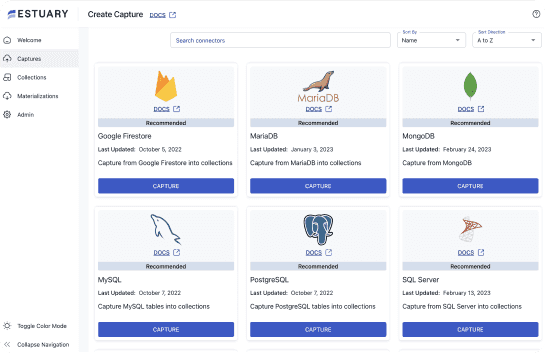
Sync jobs failing repeatedly in production is one of the most frustrating scenarios a data engineer can face. If you’re using Airbyte, chances are you've experienced your pipelines crashing, timing out, or simply stalling, creating operational headaches and undermining trust in your data infrastructure.
This guide’ll explore why Airbyte sync jobs frequently fail, the underlying issues causing this unreliability, and how you can achieve a stable, stateful alternative with Estuary Flow’s robust streaming data integration.
Quick Summary (TL;DR)
Airbyte sync jobs fail in production primarily because of the following:
- Unstable connectors prone to crashes
- Inefficient state management leads to full reloads
- Limited retry mechanisms causing manual interventions
Estuary Flow addresses these reliability issues by:
- Maintaining robust state management
- Supporting automatic recovery and retries
- Ensuring exactly-once processing and consistent delivery
Let's dive deeper into these issues and the solutions available.
Why Do Airbyte Sync Jobs Fail So Often?
Problem 1: Unstable Connectors and Frequent Crashes
The most common complaint among Airbyte users is that connectors, especially community-maintained ones, regularly crash or stall during production syncs. Because Airbyte relies heavily on community contributions, connector quality is often inconsistent. Even officially supported connectors occasionally break when encountering real-world scenarios, such as high-volume data or schema complexity.
This instability leads to unpredictable job failures that disrupt data workflows, causing data engineers to troubleshoot or manually restart pipelines constantly.
Problem 2: Inefficient State Management and Lost Progress
Airbyte’s method of tracking incremental progress is not robust enough. Many connectors fail to persist or properly recover the sync state, meaning that if a job crashes or is interrupted, it may revert to a complete refresh. This inefficiency multiplies the processing load, increases latency, and places unnecessary strain on source systems.
For example, MongoDB incremental syncs with Airbyte often fall back to a complete refresh due to missing or corrupted resume tokens. This overloads your MongoDB instance and can significantly slow down downstream processing.
Problem 3: Limited Automatic Recovery and Retries
When Airbyte encounters a failure, it often requires manual intervention or restarts. Automatic retries are either limited or unreliable, especially for complex CDC (change data capture) connectors. This manual dependency is a significant operational overhead, distracting engineering teams from strategic projects and forcing them into continuous firefighting.
Real-World Experiences from Data Engineers
One data engineer shared their experience on Reddit, stating, "I have a pretty bad experience with Airbyte. It was unstable, error-prone, and slow." Another echoed these concerns, noting that sync jobs were "crashing at least once daily," severely impacting their workflow and causing unnecessary operational overhead.
Stories like these highlight the core problem: Airbyte, despite its potential, struggles with fundamental reliability issues at scale.
How Frequent Failures Impact Your Business
When data sync jobs fail frequently:
- Analytics and business intelligence tools rely on incomplete or stale data.
- Critical business decisions become risky due to unreliable data.
- Operational teams spend excessive time on reactive troubleshooting rather than proactive improvements.
- Increased downtime and data discrepancies undermine trust in your data infrastructure.
Introducing Estuary Flow: A Reliable Airbyte Alternative
To solve these persistent reliability issues, data engineers need a solution that ensures stability, consistency, and minimal operational overhead. Enter Estuary Flow.
State Management Built for Reliability
Estuary Flow addresses Airbyte’s weaknesses by using robust, fault-tolerant state management. Flow maintains precise checkpoints that guarantee incremental syncs resume precisely where they left off, preventing unnecessary full refreshes and significantly improving performance.
Flow’s architecture ensures that incremental loads remain consistent, saving compute resources and protecting source systems from unnecessary load even after failures.
Automatic Recovery and Retries
Unlike Airbyte, Flow features sophisticated retry logic and automatic error recovery mechanisms. Flow automatically retries the sync with intelligent exponential backoff if a connector encounters an issue. This means fewer manual interventions and far less operational overhead.
Flow’s built-in resiliency ensures that transient issues, such as temporary network problems or minor source disruptions do not derail your entire data pipeline.
Exactly-Once Delivery Guarantees
Estuary Flow ensures exactly-once semantics throughout your data pipelines. This means data is delivered reliably and accurately without duplicates or data loss. In contrast, Airbyte’s at-least-once semantics can result in duplicated or missing records, creating data integrity issues and additional deduplication overhead.
Exactly-once delivery means cleaner, more trustworthy data and reduces the complexity of downstream processing.
How to Migrate from Airbyte to Estuary Flow
Switching from Airbyte to Estuary Flow is straightforward and typically involves:
- Connector Migration: Estuary maintains and supports robust, production-grade connectors for familiar sources like MongoDB, PostgreSQL, SQL Server, and Snowflake.
- Pipeline Configuration: Flow uses a simple, declarative configuration language that defines data pipelines clearly and concisely.
- Automated Validation: Flow includes built-in schema validation and monitoring that immediately surfaces pipeline health and integrity issues.
Migrating to Estuary Flow often results in immediate improvements in reliability, data freshness, and operational overhead reduction.
Want a deeper look at how these two platforms compare? Check out our in-depth comparison on Estuary vs Airbyte.
Case Study: Headset Migrates from Airbyte to Estuary Flow
Headset recently migrated from Airbyte after facing daily connector crashes and costly downtime. Within days of adopting Flow, their sync failures dropped to near zero, dramatically reducing operational firefighting. Their engineers shifted from reactive fixes to proactive optimization, driving measurable improvements in data reliability and organizational efficiency.
The customer reported:
- Sync job reliability improved from daily failures to consistent uptime.
- Engineering resources spent troubleshooting pipelines were reduced by over 60%.
- Data freshness significantly enhanced, enabling faster business decisions.
Key Takeaways: Why Reliability Matters
Data engineers shouldn't spend their days troubleshooting unstable pipelines. Reliability is foundational to practical data engineering and essential for data-driven decision-making.
Estuary Flow offers:
- Robust, fault-tolerant connectors designed for production-scale use.
- Stateful incremental syncs to avoid redundant processing and overloads.
- Automatic retries and recovery to reduce manual intervention.
- Exactly-once semantics to ensure trustworthy, consistent data.
Final Thoughts
Airbyte’s frequent sync failures are not merely technical annoyances—they have real business implications, impacting decision-making, operational efficiency, and revenue. By transitioning to a reliable, modern data integration solution like Estuary Flow, you ensure that your data pipelines consistently deliver fresh, accurate data without requiring constant manual intervention.
Reliability isn’t optional—it's the cornerstone of a successful data engineering strategy.
Ready to experience reliability in action? Try Estuary Flow today and eliminate your Airbyte sync headaches for good.

About the author
Dani is a data professional with a rich background in data engineering and real-time data platforms. At Estuary, Daniel focuses on promoting cutting-edge streaming solutions, helping to bridge the gap between technical innovation and developer adoption. With deep expertise in cloud-native and streaming technologies, Dani has successfully supported startups and enterprises in building robust data solutions.











